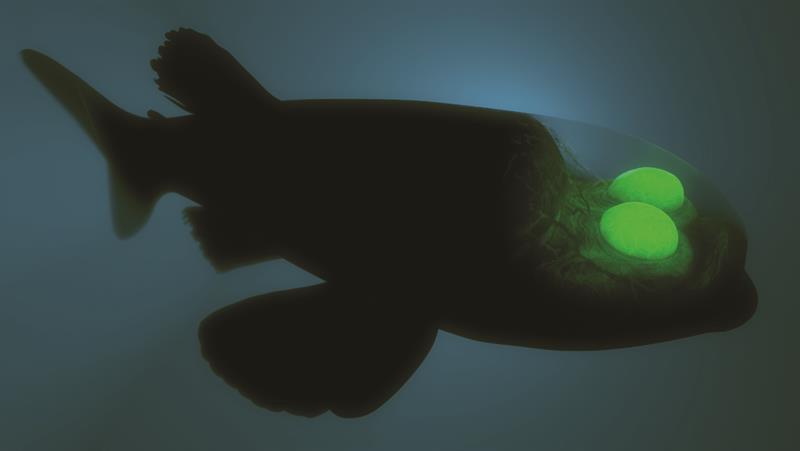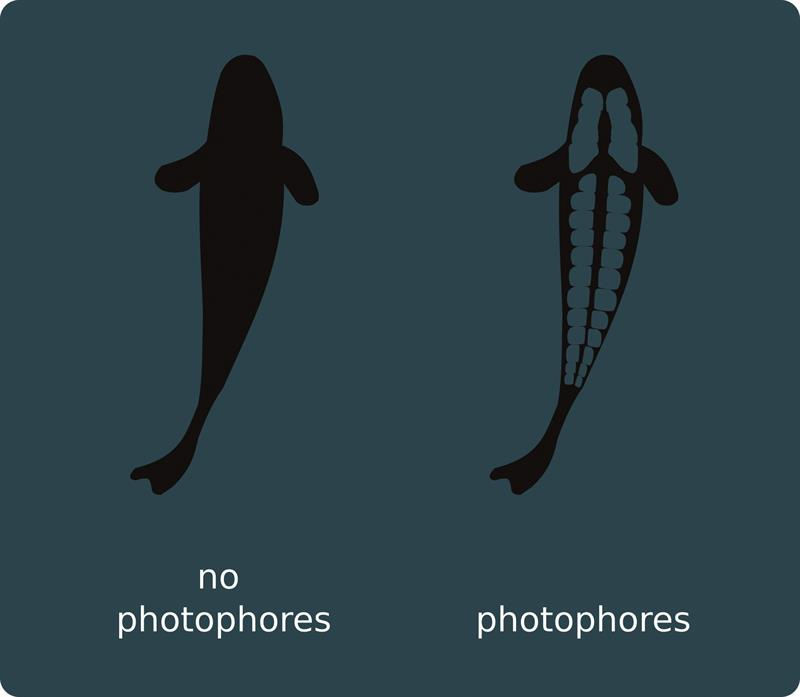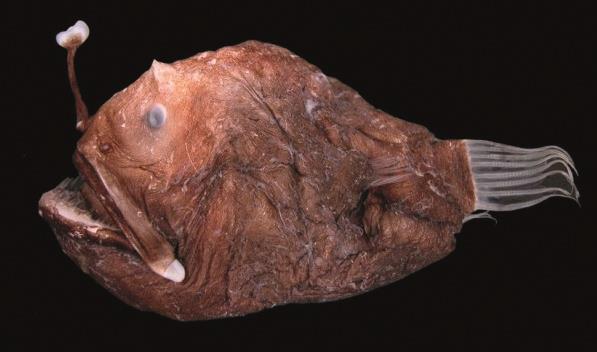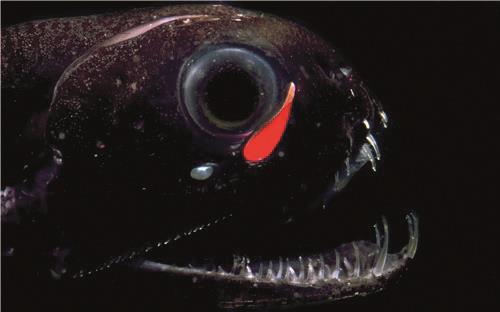Given that over 70% of our planet is covered in water, it is hardly a surprise that the oceans are the least explored corners of our world. Each excursion we make into the depths reveals strange new animals whose lives are almost unimaginably different from our own. In this article, I will highlight some of their weird and wonderful visual systems; nevermind outer space, aliens, it turns out, live right here on Earth.
The ocean is broadly divided into four zones: the sunlight zone (0-200m), the twilight zone (200-1,000m), the midnight zone (1,000-6,000m), and the sinisterly named abyssal zone (below 6,000m). As the names of these zones suggest, the deeper the water, the darker it gets. That is because light does not travel as well through water as it does through air.
Sunlight can penetrate pretty well through the first 200m of water, which is why this uppermost zone is referred to as the sunlight zone. Most of the fish and sea creatures that we are familiar with live in this zone. There is enough light for animals to be able to see their surroundings and for photosynthesis to occur. However, descend below 200m and there is almost no sunlight, certainly not enough to support photosynthesis. This is the twilight zone. Dropping even deeper still, past 1,000m and there is complete darkness. The sunlight bathing the surface of the ocean will never reach these depths. This is the midnight zone and it is completely devoid of sunlight. So, how do these light-environments affect the vision of the animals that live in them?

Aside from the colour of light being different in the water of the sunlight zone (red light does not travel as far in water as blue and green), the light profile is similar to most terrestrial habitats. Correspondingly, the eyes of fish in this zone are not too dissimilar to our own. That changes as we go deeper into the twilight zone. To understand the vision of animals here, it is vital to understand the overall environment.
Three-dimensional world
Unlike on land, where there is a landscape made up of earth, rocks and foliage, the open ocean is just that; a vast open three-dimensional space. Away from the ocean floor, the environment is almost uniform with water above, below and all around. Consequently, there is no convenient cover where an animal can hide from a predator, instead their only option is to avoid being seen in the first place.
The other factor that affects vision in the deep is that the light in the open ocean is directional. On land, although the sun is (almost) directly overhead, the light is scattered across the sky and from the landscape itself. In other words, light hits our eyes from all directions. It is similar in the shallow sunlight zone of the ocean too. Light can be thought of as omnidirectional, however, that changes the deeper you go. In the twilight zone, it gets noticeably darker with depth, and in the open water there are no objects like rocks or coral reefs to reflect light.
As a result, light becomes directional; looking up will always be brighter than looking straight ahead or downwards. The significance of this for both predators and prey living in this open, three-dimensional world is that for any observer looking upwards, an animal passing overhead will appear visibly silhouetted against the slightly brighter distant surface. The contrast between animal and background is very slight, but for eyes that are sensitive enough, like those of the barreleye fish, it is just enough to spot its next meal.
The barreleye is a bizarre looking fish. The top half of its head is almost completely transparent, encasing two dome-like eyes. Amazingly, the barreleye can swivel these eyes within their fully transparent head to either face directly upwards, towards the distant light of the surface, or directly in front of it. They specialise in ambushing prey from underneath, having first spotted their dark silhouette. Of course, they themselves are not immune from predation (there is always a bigger fish), so being able to move their eyes from an upwards to a forward-direction is an imperative.
Defend and attack
To avoid becoming someone else’s next meal, animals in the open ocean have two options: to become invisible or to spot the predator and escape before they are seen by it. Invisibility can be achieved in a multitude of ways. Some animals make themselves transparent while others have adapted their colouration to blend in with the surrounding water. Some small shrimp and other crustaceans have evolved bodies that are almost completely see-through; their entire bodies are transparent except for their eyes. It is impossible to make an eye completely transparent as their whole purpose is to absorb light in order to see, and by definition, light that is absorbed will no longer be visible, and, thus eyes will always be darker than their surroundings. However, these animals are able to make their eyes as inconspicuous as possible by using pigments that match the colour of the surrounding water or, rather than having two large obvious eyes, have a multitude of smaller eyes distributed around the body.
The shiny scales of many fish species can act as camouflage, reflecting the light from its surroundings back at a predator like a mirror and becoming, effectively, invisible. However, this strategy does not work if the predator is looking at them from below, as in the case of the barreleye I described previously. But even here, nature has found a solution. Some small fish like the lantern and hatchet fishes actively use light to avoid detection. Lighting yourself up to avoid being seen may sound counter-intuitive, but consider that it is their dark silhouette against the brighter water of the distant surface that is giving them away. These fish have evolved light-emitting patches on the underside of their body called photophores. These regions are packed with bacteria that, under the right conditions, produce a chemical reaction that gives off light. This light almost perfectly matches the light from the surface, effectively hiding the animal’s silhouette and making it almost invisible. This light is called bioluminescence, and this is far from the only way it is used by deep ocean animals.
Lack of light
The other strategy of evasion by spotting the predator before being seen is made difficult by the overall lack of light in the twilight zone. An animal needs to collect as much light as it possibly can in order to see anything at all. Consequently, the relative size of an animal’s eyes compared to its body increases with depth, much in the same way that nocturnal animals have larger eyes than diurnal animals. In a previous article, I talked about the largest eyes on earth, which belong to the colossal squid, an inhabitant of the twilight zone. The colossal squid’s vision is all about spotting predatory whales in the dimness before the whale has seen them and can launch an attack. Eye size correlates with depth through the sunlight zone down through the twilight zone up to the midnight zone, where there is no longer any sunlight and, regardless of how big the animal’s eyes are, there is no light to catch.
The closest equivalent terrestrial environment to the utter darkness in the midnight zone are deep cave networks. Here, the animals who live their lives completely separated from the light of the sun tend to have rudimentary eyes, or to lack them altogether. However, that is not generally the case in the deep ocean, where almost all animals have eyes, even in the dark midnight zone. But, vision relies on light and if there is no sunlight, then how are these animals seeing?
It turns out that, while sunlight may never reach these depths, the midnight zone is not as dark as its name would have you believe. Instead, the waters are constantly lit with brief blue-green flashes or weak, but steady, glowing points of light that emerge from the darkness. Similar to the laternfish, many species of deep sea fish and other animals like crustaceans cultivate populations of bacteria that are capable of producing light when triggered. The animals are using this bioluminescence both to capture prey and to evade predators.
Seen from below, a fish’s dark silhouette can be seen against the slightly brighter background of the distant surface. Laternfish and hatchetfish have light-emitting patches on the under sides of their body that emit bioluminescent light that matches the background surface, acting like camouflage to reduce their obvious silhouette

Some deep sea fish, like the anglerfish, use their bioluminescence to attract prey. They have a long spine above their mouth that ends in a fleshy lure that is filled with bioluminescent bacteria. Like the bait on a fishing pole, the blue glow emitted by the lure draws the attention of passing creatures, which on drawing closer to examine the light, end up within reach of the anglerfish’s formidable jaws. Quite why they would be attracted to such light in the darkness is unclear, but it seems that they are.
Anglerfish are so-called as they attract their deep-sea prey with a bioluminescent lure. (Masaki Miya et al. Evolutionary history of anglerfishes: a mitogenomic perspective. BMC Evolutionary Biology 2010, 10:58 CC BY 2.0)

Light my way
The more obvious use of your own personal light source, in an otherwise dark world, is to shed light on what is around you. Many deep sea fish have photophores located under or in front of their eyes that are similar to those on the underside of the laternfish. These light-emitting patches act as headlights, allowing the fish to see potential prey. Most bioluminescence is blue-green, possibly because shorter wavelength blue light travels further in water than red light, and correspondingly most fish that live below even 10m are not sensitive to red light, only to blues and greens. It was a surprising discovery, then, when a fish was found to have photophores that emitted red bioluminescence, rather than blue.
The fantastically named stoplight loosejaw fish has come up with a solution to the one major drawback that any fish with its own light source has; by lighting up their surroundings, they are making themselves potential targets for their own predators. By having red headlights, and eyes sensitive to red wavelengths, the stoplight loosejaw effectively has its own private light. It can see the world, but most of the rest of the world cannot see it in return. Meaning it can ambush prey without being spotted and avoid being eaten in turn.
Bioluminescence can also be deployed as a means of defence. When startled, several species of deep-sea amphipod (a type of crustacean that looks like a cross between shrimp and woodlice, both of which they are genetically related to) release a plume of bioluminescent bacteria into the water, creating a sudden flash of light that can either startle a would-be predator or to make the predator itself a target for a bigger fish. It is effectively a deep-sea burglar alarm. Sometimes, this bacteria can even stick to the other fish, marking it out in the vastness of the deep where there is nowhere to hide.
While each of the animals I have mentioned are worthy of their own articles, I have hopefully shone a light (pun most definitely intended) on the bizarre, alien world of the deep ocean and the animals that not only live but thrive in the darkness.
- Dr Ilse Daly is a research associate at the School of Biological Sciences at the University of Bristol.
The stoplight loosejaw fish has its own private set of headlights. The red patches beneath its eyes emit red bioluminescence, which is effectively invisible to the rest of the deep sea world as the fish cannot see red, unlike the stoplight loosejaw
Photo: ESRI, Dr Beinart, Tracey T Sutton

